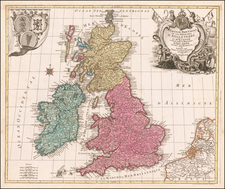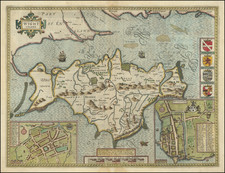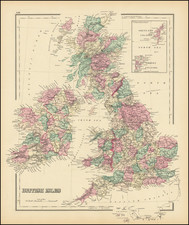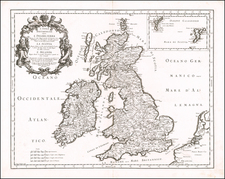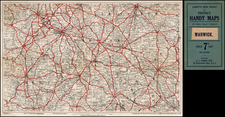Celebrating the Hanoverian Succession
Striking example of George Willdey's rare map of the British Isles, celebrating the ascension of George I, the Elector of Hanover, to the throne of England.
This lavishly decorated map is dedicated to George I, in the year after he succeeded Queen Anne as ruler of Britain. It is filled with symbols and vignettes that underline George’s legitimate claim to the throne, a claim that was hotly disputed at the time.
The King himself is shown in a portrait in the upper left corner. The dedication to him is in a cartouche just below the portrait. This cartouche is flanked by suits of armor and battle flags, suggesting George I as a martial and manly leader. The crown and scepter are nearby, as is a slogan associated with the Hanoverians, nec aspera terrent, or undaunted by difficulties.
Just below these is a classical scene of heroism. Hercules slays the many-headed hydra while a regal soldier in a crested helmet trumpets his valor. The hydra was mean to represent rebellion—a reference to the Jacobites who wanted to restore the Stuarts to the throne.
In the upper right corner is a large royal crest. Below this is a huge ship of the line, surrounded by smaller vessels in a triumphant procession—an imagining of George I’s arrival at Greenwich. The poem accompanying the image underlines George’s legitimacy as King:
Hail George! the Bulwarks of thy Realm Survey,
Both Land & Sea thy Sovereign Power Obey!
What Rival dares dispute thy Lawful Claim
Since they give Strength to Thee, and thou to them?
The map itself is quite informative. It shows the British Isles, including Ireland, as well as the Orkneys and the Western Islands. Notes offer historical and economic information. For example, the Western Islands have “Plenty of Cod & Ling all about.” The island of Iona has St. Ouran’s Church (St. Oran’s), “Famous for ye Buruing place of 8 Kings of Norway 48 of Scotland 4 of Ireland and many other Persons of Distinction.”
An explanation in the Atlantic lists all the information contained in the map. It shows major and minor roads and tells the distance between towns and cities. There are symbols to denote universities, bishoprics, archbishoprics, towns that elect Members of Parliament, and post towns.
The map also includes an elaborate advertisement at the bottom left corner showing the wares offered by George Willdey. Willdey operated "the Great Toy Shop next to the Dog Tavern in Ludgate Street." His trade card employed similar imagery. Willdey’s shop was well known and had many famous clients, including the Prince and Princess of Wales—the future George II and his wife, Caroline.
The Hanoverian Succession
In 1714, Queen Anne died; she had no children, leaving no heirs to the British throne in Britain. This problem was a long time coming. A century earlier, in 1603, Elizabeth I died with no heirs after reining for 45 years. She chose her closest living relative, King James VI of Scotland, to succeed her. They were both direct descendants of Henry VII; Elizabeth was Henry’s granddaughter, while James was his great-great grandson.
James I of England and VI of Scotland was the first monarch of the Stuart dynasty. He and his wife, Anne of Denmark, had three children, Henry Frederick, Elizabeth, and Charles. After Henry Frederick’s premature death in 1612, Charles became heir to the throne. Charles I married Henrietta Maria of France and they had three children: Mary, Charles, and James. Charles I was deposed following the English Civil War and executed in 1649.
After the Interregnum (1649-1660), the Stuarts regained power, with Charles II taking the throne. Although Charles had at least a dozen illegitimate children, his marriage to Catherine of Braganza yielded no legitimate heirs. When he died in 1685, his brother was crowned James II.
James II lost his first wife, Anne Hyde, in 1671, and he then married Mary of Modena. His first marriage resulted in the birth of two daughters, Mary and Anne. His second marriage produced a son, James Francis, and a daughter, Louisa Maria Theresa.
Mary of Modena was a devout Catholic and James had converted to Catholicism in 1669. After the religious upheaval of Henry VIII’s reign, which resulted in the creation of the Church of England, English monarchs had been Protestant (with the exception of Mary I, Henry VIII’s daughter with Catherine of Aragon, who remained a Catholic). The country too became predominantly Protestant, with Catholics held in suspicion of their loyalties. Thus, when James took the throne in 1685, many feared a return of Catholic influence. Indeed, while King, James II sought to grant civic equality to Catholics and Protestant dissenters, stances that made him unpopular with Parliament. When James Francis was born in 1688, the English nobility feared that a Catholic succession was inevitable. Rather than accept the situation, they sought another alternative.
James’ daughter, Mary, had been raised a Protestant. She had married William of Orange, who was also the son of James II’s sister. At the behest of many of the English nobles, William landed an army at Devon in November 1688. The army and navy did not resist and James fled the country. Parliament later decided that his abandonment of the throne was the same as abdication and named William and Mary as joint monarchs. They also passed a Bill of Right that clarified the line of succession. If either spouse died, the other would continue to rule alone. As William and Mary were childless, the crown would pass to Mary’s sister, Anne, and her children upon their deaths. It also explicitly excluded Catholics and those married to Catholics from the throne.
Although Anne had borne many children, none of them survived childhood. In 1701, Parliament passed the Act of Settlement to further clarify the succession. It bestowed the crown on the family of Sophia, Dowager Electress of Hanover. James VI and I’s daughter, Elizabeth, had married Frederick V, the Elector Palatine. They had thirteen children. Of these, only one was left alive and not a Catholic in 1714: the twelfth child, Sophia. She pre-deceased Queen Anne by only six weeks, which meant that the next heir was her grandson, Georg Ludwig, the Elector of Hanover.
In crowning Georg as George I, Parliament passed over more than fifty closer blood relatives that were Catholics. The Elector of Hanover and now King of England spoke very little English when he took the throne. His coronation took place on October 20, 1714, ushering in the rule of the House of Hanover, which stayed in power until Queen Victoria died in 1901.
States of the Map
The present map is Willdey's second map of the British Isles. There are 3 states of the map:
- State 1 (1715): Dated 1715 in the title cartouche and bearing only Willdey’s imprint.
- State 2 (after 1750): Date in the title cartouche erased and the imprints of Thomas Jefferys and William Herbert added above the bottom neatline. (one copy known, private collection)
- State 3 (1778): Plate heavily reworked, with Richard Marshall's imprint appears in both the newly engraved title cartouche and above the bottom neatline, where the date 1778 is also engraved. (one copy known, private collection)
George Willdey was an optical instrument maker. He also sold globes, maps, and toys at his shop in Ludgate Street. Born in Staffordshire, Willdey moved to London after the death of his father, where he was bound as an apprentice to John Yarwell, an optician. He was made free of the Spectaclemakers’ Company in 1702, when he began work as a journeyman.
A few years later, Willdey started in business with Timothy Brandreth, working under the sign of the Archimedes and Globe. They competed for business with Yarwell and other opticians, advertising their wares in trade cards and periodical advertisements.
Willdey and his wife, Judith, had five children, three of which survived to adulthood. Judith was a Huguenot, which allowed Willdey to create a wider network of artisans and craftsman. He expanded his stock to toys and household decorations, in addition to instruments. From 1709 he also sold printed goods, including maps and globes, which he sold in partnership with John Senex. Willdey purchased the copper plates for many maps, such as Christopher Saxton’s atlas of England and Wales.
We note the following addresses:
- From 1707 to 1713 he operated "At the Archemedes & Globe, Ludgate Street." sometimes described as "Archimedes and Globe next the Dog Tavern nearer Ludgate."
- In 1712 in partnership with Timothy Brandreth also advertised at Archimedes and Globe over against the Royal Exchange in Cornhill.
- In 1715 his location was described as "At the Great Toy and Print Shop, the corner of Ludgate Street, next to St. Paul's"
- 1718 to 1737 as "At the Great Toy, Spectacle, China-Ware, and Print Shop, the Corner of Ludgate Street near St. Pauls London."
In 1717, Willdey split with Brandreth and expanded his stock further to include coffee and tea, snuff, medicine, china, and cutlery. He sold these wares from his shop at Ludgate and St. Paul’s Churchyard. He aggressively advertised his business in hundreds of newspaper advertisements; he also adopted many advertising gimmicks, such as erecting a giant burning glass on the roof of his store. Willdey was a leader in the Spectaclemakers’ Company. His wife frequently helped with the business and eight of his fifteen apprentices were women, which was very unusual for either the instrument and toy trades at the time.
Willdey died in 1737, although he had been in declining health for years and had tried to pass the business to his son, Thomas. He was remembered in The Old Whig, or, the Consistent Protestant as the “most noted Toyman in Europe.” After his death, the shop was run by Judith along with a former apprentice, Susanna Passavant. Thomas, it seems, was not suited to business.
Willdey’s daughter, Jane Frances, married a Peter Fenoulhet, clerk of the entries in the Excise Office. Fenoulhet sued on behalf of their son over the mismanagement of the family business by Thomas. These lawsuits produced eleven inventories of household and commercial stock between 1730 and 1737, the only extant shop accounts from the London instrument trade from this period.









